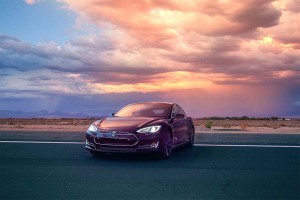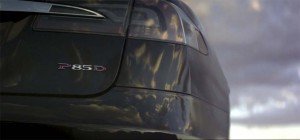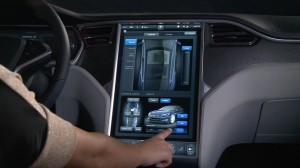The Tesla Model S P85D not only received the best score of any vehicle ever tested by Consumer Reports magazine, it somehow managed to earn 103 points on a 100-point scale, the often skeptical non-profit magazine has announced.
The P85D is the longer-range, higher-performance version of the Tesla battery-electric sedan that already was hailed by Consumer Reports in previous tests. The latest glowing review comes despite a warning issued by the magazine in May that a P85D it was using had become “undriveable” because of a series of problems.
“When the Model S P85D was evaluated at Consumer Reports’ test track in East Haddam, Connecticut, it initially earned a raw 103-point score in a system that by definition doesn’t go past 100. Consumer Reports had to make changes to its scoring methodology to account for the car’s exceptionally strong performance,” the magazine said in its new report.
Among other things, CR declared the P85D the quickest car it has ever tested, though it also noted it took a full 3.5 seconds to launch from 0 to 60, rather than the 3.1 seconds claimed by Tesla for this version of the Model S. The California carmaker recently said it is preparing a new version of the Model S that will be able to cut launch times down to 2.8 seconds in what it calls “Luuudicrous Mode.”
(For the latest news on Tesla products — and finances — Click Here.)
“The P85D represents a glimpse into the future of automotive technology in which cars will be more energy-efficient than ever, while still delivering a terrific blend of performance and practicality,” said Consumer Reports’ director of automotive testing, Jake Fisher. “The Tesla is a shining example of how higher fuel economy standards can be achieved without sacrificing performance.”
Until recently, the P85D was the longest-range version of the Tesla Model S, capable of 253 miles per charge, according to the EPA. A new P90 model is expected to nudge the 300-mile barrier, however. With two electric motors, meanwhile, the Model S P85D was the first Tesla to offer all-wheel-drive.
The record-high rating exceeds the numbers landed by such vaunted competitors as the Mercedes-Benz S550, the big luxury sedan garnering a 96, as well as the 99 points an earlier version of the Model S earned in 2013.
The announcement might come as a surprise to some, however. In May, CR said a version of the $127,000 it was testing P85D turned out to be “undriveable,” because of problems with the automatic door handles that are supposed to extend out when someone with the key approaches the vehicle. It’s an issue that others have been complaining about.
(CR calls earlier Tesla “undriveable.” Click Here for more.)
CR last year noted that owners have complained about some other glitches with the Model S, stating that the battery sedan has had “more than its share of problems.”
And in the latest review, the magazine did cite a few concerns, noting, “The interior materials aren’t as opulent as other six-figure automobiles that the organization has tested, and its ride is firmer and louder than the base Model S.”
Meanwhile, the magazine echoed broader concerns about electric vehicles, adding that, “While no other fully electric car comes close to its 200-mile-plus range, a lengthy road trip can be a logistical hurdle if a quick-charging station isn’t along the route.”
Tesla has been trying to address that issue by setting up a network of so-called “Supercharger” stations across the U.S. They allow a driver to get an 80% recharge in as little as 15 minutes. But Tesla has also cautioned motorists not to always rely on the Superchargers. Many battery experts warn that such high-speed systems can reduce battery life.
(Tesla announces first incentive program – but gives it a social spin. Click Here for more.)




Most battery experts are not expirienced with lithium type batteries. According to Nissan actually wants nissan leaf owners to charge at level 2 not level 1 cause of of reduction of temperature. . When a lithium battery charges and discharges things get warm. Tesla chargers are DC and can transfer tremendous amount od energy because of a actual cooling system of the battery. Reduction of heat buildup increases battery life.
Consumer Reports credibility left the building decades ago when they claimed Toyota and Honda models were the greatest thing since sliced bread. Tesla is spinning it’s wheels with fast charging stations. It just does not work for most auto consumers.
Sounds like consumer magazine has gotten into bed with liberals
When the rating system allows greater than a perfect score of 100, there is obviously something wrong with the system.
Considering Li-ion batteries in EVs are not delivering the claimed 10-12 year usable lifespan, rapid charging will just lower the lifespan to probably 5 years or so. I wonder how many EV owners are going to be happy with the replacement battery costs which is significant.
From the Tesla website:
“A Battery Replacement Option will be available for purchase soon. The option allows you to pre-purchase a new battery to be installed after eight years for a fixed price: $8,000 for 40 kWh batteries, $10,000 for 60 kWh batteries, and $12,000 for 85 kWh batteries.”
Tesla has impacted high-end, luxury, performance car market which needless to say, causes angst in the GM, BMW, Mercedes board rooms. Their response has been to come out with power, electric and hybrid electric models so they don’t at least look so dumb.
Now I have my own issues with Consumer Reports including: (1) closed definition of their mileage tests, and (2) close definition of the formula used to set a ranking. I did an analysis a couple of years ago and found their primary requirements were ‘comfy chair’ for the driver and an undocumented acceleration requirement. Efficiency plays no part in their scoring.
As for the rich and successful liberals who can buy these cars, perhaps our poor cousin conservatives should ‘get a clue.’ Liberal also means the ability to innovate, succeed and buy a Tesla.
Bob Wilson, Huntsville AL
At gt101:
Does not work for most Auto consumers. Yeah, most auto consumers… that drive over 250 miles one way, then 10 minutes later, need to return, AND, don’t have a 2nd car. What driving percentage is that – maybe 1/100 of 1%? Id toy say so.
Range anxiety is not the only problem with EV’s, it’s just the primary issue. That 250 miles is under ideal conditions. Try getting 250 miles range in cold weather areas of the country in Winter or in snow or in heavy rain or with the heater/defroster turned on and you’ll find that 250 miles just became 150 miles or less.
In addition if there is no charging station wherever you’re traveling your SOL and must go out of your way to recharge or use a different vehicle. Not many people are going to buy a car that can only be driven where there is a charging system. Did I mention that electricity and replacement batteries are not free?
Having to own a second car for travel is still a huge issue for most people, particularly young, low income, elderly, etc. As many have pointed out EVs are toys for those of means to imply they are being environmentally responsible. These people typically fail to investigate the toxic battery production and end of life battery handling, the fire liability for these cars before or after an accident or while stored in a garage, the overheating charging systems that have caused home wiring systems to overheat and more. It’s very convenient to ignore these serious shortcoming when promoting impractical products as some shills like to do.
Of course if your objective is to deceive people then using an absurd and distorted view of reality might fool some people but consumers are pretty much saying no thanks to EVs especially now that many states are eliminating subsidies and charging EV operators for highway use. Probably in the near future EV owners will also be charged for disposal of the toxic batteries.
If not for government grants and subsidies the still losing $4000 per model S sold Tesla
would not even exist.
Recall, GT, without government subsidies we never would have had the early canal system, the railroad system, the air transport system, the Interstate system…indeed, the gas-powered automobile itself. How much of our massive defense budget is a subsidy of the oil industry, for example?
Please understand I am not defending EV subsidies, but some perspective is useful if we are to have a valid discussion.
Paul E.
Paul, recall that EVs are not mass transit and they should not be subsidized because they are impractical for most people. Trying to equate RVs to mass transit is silly and disingenuous.
I see the flat earth have started their the sky is falling chant yet again. Their fear of things changing shows their cave man proproganda thoughts. Going back to beginning if the introduction of the automobile when an man had to walk before an automobile with a flag to warn horse drawn buggies is their true speed. This site is nothing more than ignorant hideout trolls for voodoo thoughts and a waste of my time.
I do take offense at that, DWH…
Paul E.
As you see Paul, DWH can’t intelligently discuss or deal with the lack of merits of EVs so he makes ignorant personal attacks to demonstrate his uncivil behavior to all.